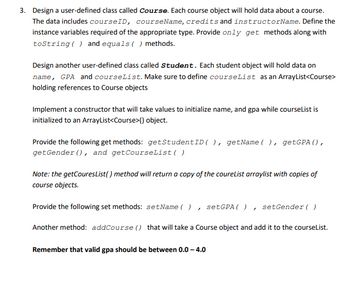
Computer Networking: A Top-Down Approach (7th Edition)
7th Edition
ISBN: 9780133594140
Author: James Kurose, Keith Ross
Publisher: PEARSON
expand_more
expand_more
format_list_bulleted
Question

Transcribed Image Text:Create a client program (Student Test.java) with the main method. Start by creating Course
objects for each of the courses you took during last spring semester. Next, create a Student
object presenting you. Use the course objects you created add them to the courseList of the
student object by calling the addCourse() method. Demonstrate the following methods of the
Student class.
• getGPA()
• setGPA()
• getCourseList() to return an ArrayList<Course> containing course objects.

Transcribed Image Text:3. Design a user-defined class called Course. Each course object will hold data about a course.
The data includes courseID, courseName, credits and instructorName. Define the
instance variables required of the appropriate type. Provide only get methods along with
toString() and equals() methods.
Design another user-defined class called Student. Each student object will hold data on
name, GPA and courseList. Make sure to define courseList as an ArrayList<Course>
holding references to Course objects
Implement a constructor that will take values to initialize name, and gpa while courseList is
initialized to an ArrayList<Course>() object.
Provide the following get methods: getStudent ID ( ), getName(), getGPA (),
get Gender(), and get CourseList()
Note: the getCouresList() method will return a copy of the coureList arraylist with copies of
course objects.
Provide the following set methods: setName(), setGPA (), setGender()
Another method: addCourse () that will take a Course object and add it to the courseList.
Remember that valid gpa should be between 0.0-4.0
Expert Solution
This question has been solved!
Explore an expertly crafted, step-by-step solution for a thorough understanding of key concepts.
This is a popular solution
Trending nowThis is a popular solution!
Step by stepSolved in 3 steps

Knowledge Booster
Similar questions
- Double Bubble For this exercise you need to create a Bubble class and construct two instances of the Bubble object. You will then take the two Bubble objects and combine them to create a new, larger combined Bubble object. This will be done using functions that take in these Bubble objects as parameters. The Bubble class contains one data member, radius_, and the corresponding accessor and mutator methods for radius_, GetRadius and SetRadius. Create a member function called CalculateVolume that computes for the volume of a bubble (sphere). Use the value 3.1415 for PI. Your main function has some skeleton code that asks the user for the radius of two bubbles. You will use this to create the two Bubble objects. You will create a CombineBubbles function that receives two references (two Bubble objects) and returns a Bubble object. Combining bubbles simply means creating a new Bubble object whose radius is the sum of the two Bubble objects' radii. Take note that the CombineBubbles function…arrow_forwardYou are tasked with defining a class Course that includes the following data members: CourseNum (int). -CourseName(string) -CreditHours(int), Department(string). Assuming you have the template: class Coursearrow_forward
Recommended textbooks for you
 Computer Networking: A Top-Down Approach (7th Edi...Computer EngineeringISBN:9780133594140Author:James Kurose, Keith RossPublisher:PEARSON
Computer Networking: A Top-Down Approach (7th Edi...Computer EngineeringISBN:9780133594140Author:James Kurose, Keith RossPublisher:PEARSON Computer Organization and Design MIPS Edition, Fi...Computer EngineeringISBN:9780124077263Author:David A. Patterson, John L. HennessyPublisher:Elsevier Science
Computer Organization and Design MIPS Edition, Fi...Computer EngineeringISBN:9780124077263Author:David A. Patterson, John L. HennessyPublisher:Elsevier Science Network+ Guide to Networks (MindTap Course List)Computer EngineeringISBN:9781337569330Author:Jill West, Tamara Dean, Jean AndrewsPublisher:Cengage Learning
Network+ Guide to Networks (MindTap Course List)Computer EngineeringISBN:9781337569330Author:Jill West, Tamara Dean, Jean AndrewsPublisher:Cengage Learning Concepts of Database ManagementComputer EngineeringISBN:9781337093422Author:Joy L. Starks, Philip J. Pratt, Mary Z. LastPublisher:Cengage Learning
Concepts of Database ManagementComputer EngineeringISBN:9781337093422Author:Joy L. Starks, Philip J. Pratt, Mary Z. LastPublisher:Cengage Learning Prelude to ProgrammingComputer EngineeringISBN:9780133750423Author:VENIT, StewartPublisher:Pearson Education
Prelude to ProgrammingComputer EngineeringISBN:9780133750423Author:VENIT, StewartPublisher:Pearson Education Sc Business Data Communications and Networking, T...Computer EngineeringISBN:9781119368830Author:FITZGERALDPublisher:WILEY
Sc Business Data Communications and Networking, T...Computer EngineeringISBN:9781119368830Author:FITZGERALDPublisher:WILEY

Computer Networking: A Top-Down Approach (7th Edi...
Computer Engineering
ISBN:9780133594140
Author:James Kurose, Keith Ross
Publisher:PEARSON

Computer Organization and Design MIPS Edition, Fi...
Computer Engineering
ISBN:9780124077263
Author:David A. Patterson, John L. Hennessy
Publisher:Elsevier Science

Network+ Guide to Networks (MindTap Course List)
Computer Engineering
ISBN:9781337569330
Author:Jill West, Tamara Dean, Jean Andrews
Publisher:Cengage Learning

Concepts of Database Management
Computer Engineering
ISBN:9781337093422
Author:Joy L. Starks, Philip J. Pratt, Mary Z. Last
Publisher:Cengage Learning

Prelude to Programming
Computer Engineering
ISBN:9780133750423
Author:VENIT, Stewart
Publisher:Pearson Education

Sc Business Data Communications and Networking, T...
Computer Engineering
ISBN:9781119368830
Author:FITZGERALD
Publisher:WILEY